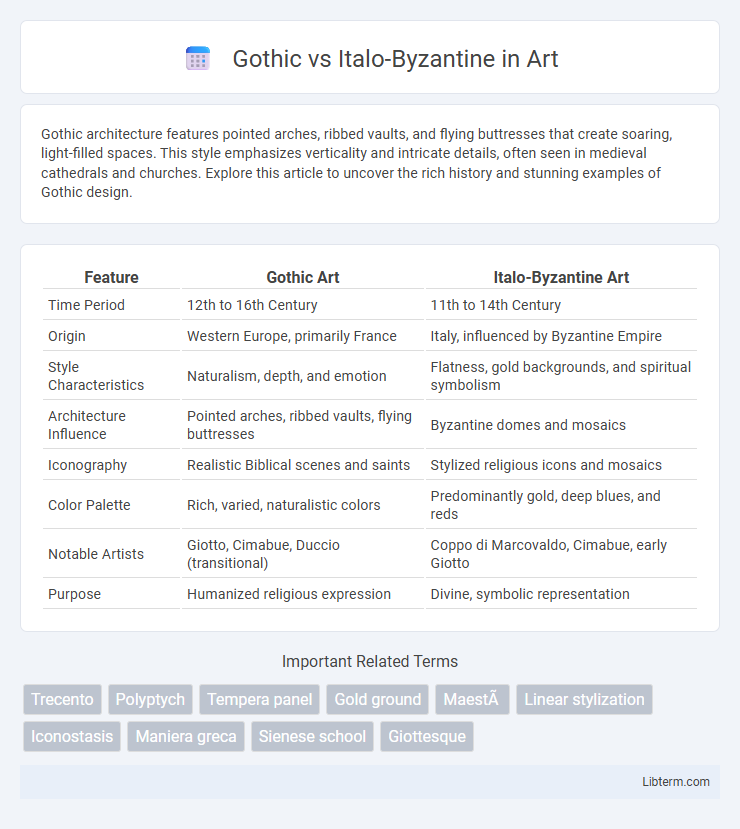Gothic architecture features pointed arches, ribbed vaults, and flying buttresses that create soaring, light-filled spaces. This style emphasizes verticality and intricate details, often seen in medieval cathedrals and churches. Explore this article to uncover the rich history and stunning examples of Gothic design.
Table of Comparison
| Feature | Gothic Art | Italo-Byzantine Art |
|---|---|---|
| Time Period | 12th to 16th Century | 11th to 14th Century |
| Origin | Western Europe, primarily France | Italy, influenced by Byzantine Empire |
| Style Characteristics | Naturalism, depth, and emotion | Flatness, gold backgrounds, and spiritual symbolism |
| Architecture Influence | Pointed arches, ribbed vaults, flying buttresses | Byzantine domes and mosaics |
| Iconography | Realistic Biblical scenes and saints | Stylized religious icons and mosaics |
| Color Palette | Rich, varied, naturalistic colors | Predominantly gold, deep blues, and reds |
| Notable Artists | Giotto, Cimabue, Duccio (transitional) | Coppo di Marcovaldo, Cimabue, early Giotto |
| Purpose | Humanized religious expression | Divine, symbolic representation |
Introduction to Gothic and Italo-Byzantine Styles
Gothic architecture, emerging in 12th-century France, is characterized by pointed arches, ribbed vaults, and flying buttresses that create soaring, light-filled interiors. In contrast, Italo-Byzantine style, prevalent in 11th to 13th-century Italy, blends Byzantine mosaics and iconography with Western architectural elements, emphasizing rich decoration and spiritual symbolism. The Gothic style prioritizes verticality and structural innovation, whereas the Italo-Byzantine emphasizes ornate surfaces and a fusion of Eastern and Western artistic traditions.
Historical Origins and Development
Gothic art originated in 12th-century France, evolving from Romanesque styles and emphasizing verticality and naturalism, particularly in architecture and sculpture. Italo-Byzantine art, rooted in the Byzantine Empire's influence on Italian regions from the 6th to 13th centuries, combined Eastern Orthodox iconography with Western medieval elements, characterized by gold backgrounds and stylized figures. The Gothic style developed through the Northern European medieval period with advancements in engineering, while Italo-Byzantine persisted in southern Italy and influenced early Renaissance artists.
Key Architectural Features
Gothic architecture is characterized by pointed arches, ribbed vaults, flying buttresses, and large stained glass windows that emphasize verticality and natural light. Italo-Byzantine architecture features extensive use of domes, rounded arches, intricate mosaics, and thick walls with small windows, reflecting a more solid and ornate aesthetic. The contrast between the soaring, light-filled spaces of Gothic cathedrals and the richly decorated, centralized layouts of Italo-Byzantine structures highlights their distinct approaches to form and symbolism.
Influential Artists and Iconic Examples
Gothic art, exemplified by artists such as Giotto di Bondone and Simone Martini, emphasizes naturalism and emotional expression in works like Giotto's frescoes in the Scrovegni Chapel and Martini's "Annunciation." The Italo-Byzantine style, with artists like Cimabue and Duccio di Buoninsegna, is marked by stylized gold backgrounds and spiritual iconography, notably seen in Cimabue's "Santa Trinita Madonna" and Duccio's "Maesta." Both styles played pivotal roles in shaping medieval visual culture, bridging Byzantine traditions with emerging Western aesthetics.
Materials and Techniques Used
Gothic art predominantly utilized stained glass, ribbed vaults, and flying buttresses constructed with stone and lead, emphasizing verticality and light in cathedrals. Italo-Byzantine art employed extensive use of gold leaf, tempera on wooden panels, and intricate mosaics, reflecting the opulence and spiritual symbolism characteristic of Byzantine influence. Techniques such as fresco painting were common in Gothic interiors, while Italo-Byzantine artists focused on meticulous iconography with stylized figures and rich, luminous backgrounds.
Regional Variations and Adaptations
Gothic art, flourishing primarily in Northern Europe from the 12th to 16th centuries, showcases intricate architectural elements such as pointed arches and flying buttresses, while Italo-Byzantine style, dominant in Italy from the 11th to 13th centuries, emphasizes flat, frontal figures with gold backgrounds reflecting Eastern Orthodox influences. Regional adaptations in Gothic art led to variations like the flamboyant style in France and Perpendicular Gothic in England, whereas the Italo-Byzantine style evolved into the more naturalistic Renaissance art through artists like Giotto. Both styles demonstrate how local cultural and religious contexts influenced iconography, materials, and thematic representation across Europe.
Symbolism and Religious Significance
Gothic art emphasizes verticality and light to symbolize divine transcendence, using intricate stained glass and pointed arches as metaphors for spiritual ascent. Italo-Byzantine art centers on iconic gold backgrounds and frontal, rigid figures to evoke the eternal and unchanging nature of the divine. Both styles convey Christian symbolism, with Gothic striving for an immersive, celestial experience and Italo-Byzantine highlighting sacred authority and religious continuity.
Artistic Innovations and Legacy
Gothic art introduced innovations such as pointed arches, ribbed vaults, and flying buttresses, enabling structures with increased height and light, profoundly influencing European cathedral design. In contrast, the Italo-Byzantine style preserved classical mosaics and iconography with rich gold backgrounds, emphasizing spiritual symbolism over naturalism. The Gothic legacy paved the way for Renaissance naturalism, while Italo-Byzantine art impacted Orthodox Christian aesthetics and maintained Byzantine traditions in Italy and beyond.
Comparison of Aesthetic Principles
Gothic art emphasizes verticality, light, and intricate detail, featuring pointed arches and elaborate stained glass that create an ethereal atmosphere. Italo-Byzantine art prioritizes flat, frontal figures with rich gold backgrounds, focusing on spiritual symbolism and a sense of timelessness rather than naturalism. While Gothic aesthetics strive for emotional expression and dynamic movement, Italo-Byzantine style maintains formal rigidity and abstraction to convey divine presence.
Lasting Influence on Modern Art and Architecture
Gothic architecture's emphasis on verticality, pointed arches, and expansive stained glass windows profoundly shaped modern architectural design, inspiring the Neo-Gothic revival and contemporary skyscrapers that emphasize light and space. Italo-Byzantine art, characterized by its rich mosaics, iconic gold backgrounds, and stylized religious figures, influenced modern religious iconography and the decorative arts, embedding a legacy of spiritual symbolism and ornamental detail. Both styles contributed to the evolution of modern aesthetics by integrating structural innovation with expressive visual language, impacting artistic and architectural practices worldwide.
Gothic Infographic

 libterm.com
libterm.com